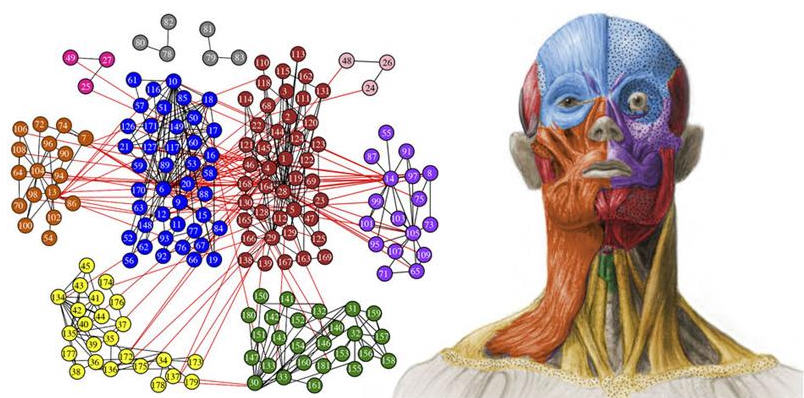Anatomical Network Analysis (AnNA) is based on network analysis mathematical tools for studying anatomy and has led to several studies of both the human skeleton and of the rest of terrestrial vertebrates, especially in regard to the development and evolution of the skull.
Now researchers have added the head muscles and cartilages to the study of the skull bones, including the inner ear bones, the jaw and the bones that connect with head muscles, such as cervical vertebrae and clavicles, and can analyze the head as a complex system defined by 181 nodes —including bones, muscles and cartilage, and excluding superficial muscles— and 412 physical contacts —sutures and cartilaginous joints. In doing so, the head can be compartmentalized into 10 modules, says Dr. Diego Rasskin.

Credit: Asociación RUVID
Each skull "generated a network model in which each bone was represented as the network node and each physical articulation (contact), as a connection. Thus, each skull was modelled as a 0-1 matrix with each connection being a 1. This matrix served to analyze the network attributes, which could in turn be compared to other generic network properties."
The functional and developmental dependences of the head as a whole cannot be separated, but are coupled in these ten modules "This modular structure allows each module to evolve semi-independently, i.e., changes in one of them has a minimal effect on others," says Rasskin.
By using AnNa, which enables the analysis of bones and muscles at the same time, new cranial functional dependences have been uncovered, because muscles —associated to movements— link separate bones. For example, as the researcher points out, the lower jaw / inner ear module shows dependences between bones associated with masticatory muscles and which would not associate otherwise (jaw to parietal, temporal and occipital) as well as inner ear bones.
Moreover, muscle modules "show left/right independence of orofacial muscles (mouth and face) from the upper face muscles. This allows greater flexibility in facial expression for we are able to move facial muscles on either side separately," he explains.
Citation: Borja Esteve-Altava, Rui Diogo, Christopher Smith, Julia C. Boughner&Diego Rasskin-Gutman (2015) Anatomical networks reveal the musculoskeletal modularity of the human head. Scientific Reports 5, Article number: 8298. doi:10.1038/srep08298






Comments